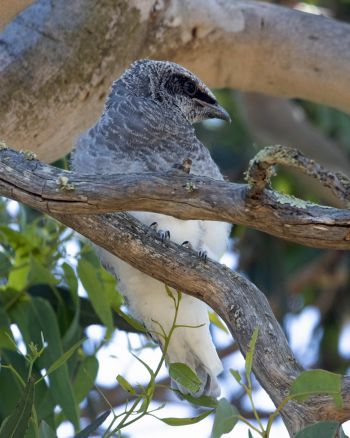- Coracina novaehollandiae
Identification
32-34cm
Medium sized shrike-like bird, part of a family unique to the southern Hemisphere.
Pale silver grey with distinctive black facial mask. Underparts white, washed grey; tail broadly margined black, tipped white.
Colour varies among subspecies and from south to north (Northern birds darker).
Similar Species
Distribution
Australasia: found in Australia, Tasmania and New Guinea.
One of the commonest and wide-spread birds in Australia.
Taxonomy
Has been regarded conspecific with Wallacean Cuckoo-shrike and Slaty Cuckoo-shrike.
Subspecies[1]
- C. n. melanops:
- Australia; winters to New Guinea, Sundas, western Solomon Islands
- C. n. novaehollandiae:
- C. n. subpallida: very pale grey, white below. Immature: smutty black mask from bill through eye to ear-coverts; crown/throat/breast finely barred greyish
- Central Western Australia (Pilbara region); winters on the Kai Islands
Habitat
Rainforests, forests, open woodlands, coastal trees. Wetlands, scrublands; timber on watercourses; orchards, parks, suburban gardens Wooded habitats and suburbs.
Behaviour
Usually arboreal, often conspicuously perches on dead trees or telegraph poles in open areas. Has benefitted from landclearing.
Has a unique 'wing shuffle' which it repeats a couple of times when landing on a perch.
Flight
Flight easy, undulating, with wing closed. Hovers over canopy, low over grass in breezes.
Diet
Forages in foliage. The diet includes insects and other invertebrates, some fruits and seeds.
Breeding
The nest is a shallow saucer of sticks and bark, bound together with cobwebs. Both sexes construct the nest and care for the young birds, which leave the nest after about three weeks of hatching.
Vocalisation
Voice: musical, rolling, churring; also chereer, chereer.
References
- Clements, JF. 2009. The Clements Checklist of Birds of the World. 6th ed., with updates to December 2009. Ithaca: Cornell Univ. Press. ISBN 978-0801445019.
- Birds in Backyards
- Graham Pizzey & Frank Knight
- BF member observations
Recommended Citation
- BirdForum Opus contributors. (2025) Black-faced Cuckooshrike. In: BirdForum, the forum for wild birds and birding. Retrieved 11 May 2025 from https://www.birdforum.net/opus/Black-faced_Cuckooshrike
External Links
GSearch checked for 2020 platform.1






